A migração do Ukulele
ERA UMA VEZ UM REI HAWAIANO QUE SE INSPIROU NUMA PEQUENA GUITARRA PORTUGUESA...

O Cavaquinho português (ou Braguinha) deu origem a muitas derivações pelo país e pelas ex-colónias. Na Madeira, com o nome de Machete viajou no sec. XIX pela mão de emigrantes para o Havai, e depois de adaptado em conjunto com o Rajão (espécies de cavaquinho maior com 5 cordas), acabou por se tornar no instrumento mais popular do Havai, que graças ao turismo acabou por difundir o Ukulele pelo mundo. Curiosamente ainda hoje permanece a gratidão e nunca esquecem de recordar as origens portuguesas do instrumento.
Pelas características divertidas, a sonoridade agradável e a simplicidade da aprendizagem, o ukulele acabou por chamar a atenção de artistas e músicos por todo mundo, transformando-se num espantoso movimento globalizado que conquista adeptos por todos os cantos do mundo e todos os géneros musicais, sendo visíveis pela Internet a proliferação de sites, vídeos, documentários etc. produzidos por entusiastas de todo mundo menos de Portugal, país originário mas onde ironicamente é muito difícil por exemplo encontrar um Ukulele à venda nas loja, acessórios como cordas ou livros etc.
Embora seja simples a sua aprendizagem, não existem professores nas escolas de música portuguesas.
Já é tempo de se fazer alguma coisa para se alterar esta lacuna cultural.
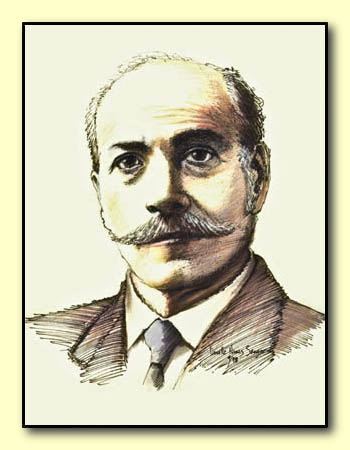 | Manuel Nunes (1843 - 1922) 1998 Hall of Fame Inductee Manuel Nunes emigrated to Hawaii from Madeira in 1879 and quickly became a major force in the transformation of the Madeiran machete to the Hawaiian ukulele. He established himself as one of the earliest ukulele makers and operated his manufacturing company for over 40 years, much longer than any of the early makers. Many of his handcrafted instruments bore the label "M. Nunes, Inventor of the Ukulele and Taro Patch Fiddles in Honolulu in 1879." His skills were inherited by apprentices such as Samuel Kamaka and his son Leonardo Nunes, who carried on the tradition of fine quality ukulele construction. |

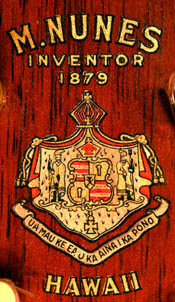 Nunes Decal circa 1915-1918 |
Ukulele pioneer Manuel Nunes was born on June 14, 1843, in Funchal, Madeira, the son of Ricardo Antonio Nunes and his wife Maria Gomes. Nunes, a young widower, was age 36 with four children (Manuel, Maria, Leonardo, Augusto) and newly married to his second wife, Isabel, age 18, when he and his family arrived in Honolulu on August 23, 1879 aboard the Ravenscrag -- the same ship that also carried fellow ukulele pioneers Augusto Dias and Jose do Espirito Santo. Five more children (John, Mary, Julius, George, Antone) were born to Nunes in Hawaii.
The Portuguese Consul General in Hawaii listed Nunes, Dias, and Santo as laborers, as they were contracted as plantation hands for their first few years in the islands. By 1884, some of the Portuguese men had returned to Honolulu and their woodworking roots. In this year, Nunes is listed in the Honolulu directory as a cabinetmaker and Dias as a guitar maker. In the following year, the first issue of Luso O Hawaii advertises both Nunes and Dias as makers of machete. By 1889, Nunes, Dias, and Santo are all in the city directory as guitar makers. Over the next decade, the combined efforts of these three men, and the patronage of King Kalakaua, popularized the new instrument that became known as the ukulele.
 Nunes signature on ukulele label |
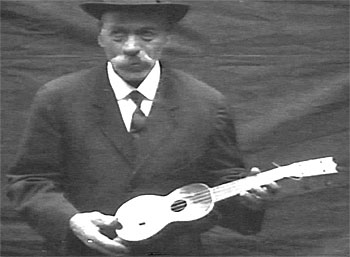 Manuel Nunes, 1917 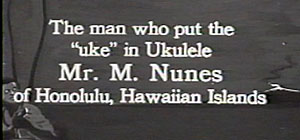 |
Nunes' sons, Julius and Leonardo, both branched out with their own ukulele manufacturing businesses. Julius returned to M. Nunes and Sons after a brief stint as manager of Nunes Ukulele Company in 1915. Leonardo, on the other hand, had left Hawaii for Los Angeles at this time, where he began making instruments labeled "Ukulele O Hawaii made by Leonardo Nunes".
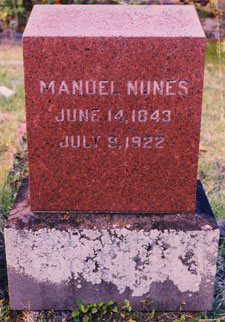 Nunes' gravestone in Honolulu, 1997 |
Angeline Nunes co-authored The Original Method and Self-Instructor on the Ukulele14 with A. A. Santos. Published in 1915, this was the first ukulele method written (actually co-written) by a woman. Angeline Nunes was the daughter-in-law of Hall of Fame Inductee Manuel Nunes, the ukulele maker (I should also mention that Angeline was the grandmother of my wife Nuni). She was married to Julius Nunes, Manuel's son who was the Nunes ukulele shop supervisor for a period of time.
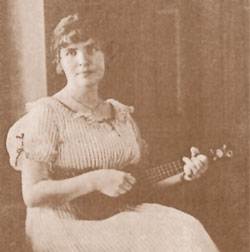 Angeline Nunes |
Sem comentários:
Enviar um comentário